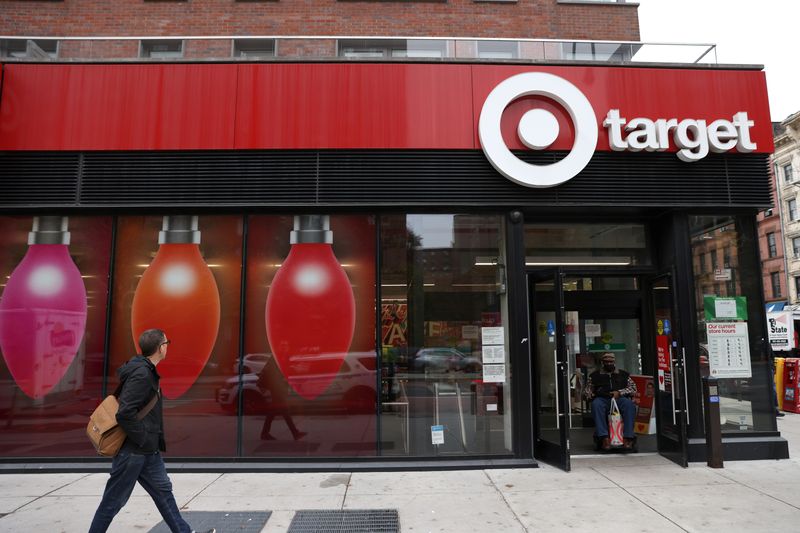By Ananya Mariam Rajesh, Siddharth Cavale
(Reuters) -Target raised its full-year profit forecast on Wednesday and reported its first increase in quarterly comparable sales in over a year, driven by price cuts that attracted more shoppers to its stores.
Target's results reflect a similar strategy employed by Walmart (NYSE:WMT) and other retailers looking to attract increasingly price-sensitive consumers. It shows that U.S. consumers are constrained but not in recession mode: they are holding out for deals but have some financial flexibility, analysts and industry watchers said.
Shares of the Minneapolis-based retailer rose 16%, touching a near four-month high of $167.40. The stock was set for its best day in over nine months after the chain said it expects 2024 profit in the range of $9.00 to $9.70 per share, up from its prior forecast of $8.60 to $9.60.
Traffic drove all its gains in comparable sales as price cuts on thousands of items proved to be a powerful lure for shoppers who have been dealing with a rapid rise in grocery prices and interest rates, the company said.
"The consumer is feeling nervous and pinched, and that will weigh on overall spending, but consumers still have plenty of purchasing power. They're just being picky about where they spend," said Brian Jacobsen, chief economist at Annex Wealth Management.
Second-quarter comparable sales, or sales from online and stores open at least 12 months, rose 2% in the quarter ended Aug. 3, the first rise in over a year. Analysts on average estimated a 1.15% rise in comparable sales, according to LSEG.
Rising prices of food and items made for immediate consumption since the pandemic have led Americans to prioritize spending on groceries and everyday essentials, while cutting back on purchases of apparel, electronics, and home goods, which are key categories for Target.
To reverse more than a year of sales declines, Target reduced prices on over 5,000 popular items, including bread, soda, paper towels, and pet food this summer. In February, it introduced a new private-label basics line called dealworthy, with most of the 400 items priced under $10. Additionally, it expanded its Good & Gather and Favorite Day brands by adding 125 new food products.
"When your budget's getting squeezed, that works in Target's favor and probably hurts Macy's (NYSE:M) and Nordstrom (NYSE:JWN), but it helps Target because they are providing a low-cost alternative," said Bill Smead, chief investment officer of Smead Capital Management, which owns Target shares worth over $170 million.
Target ran its Circle Week sales event in July, with an early focus on back-to-school products, which stimulated interest among shoppers, driving online sales up 8.7% in the quarter.
Brian Cornell, Target's Chief Executive Officer said "newness," price cuts and sales events were key factors that drove a 3% rise in visits to its nearly 2,000 stores. This was a turnaround from the 1.9% traffic decline in the prior quarter.
"They are among the few retailers with Walmart and Costco (NASDAQ:COST) ... that have been getting positive traffic to the stores and traffic is ultimately what you want because that really does translate into better sales," Telsey Advisory Group analyst Joseph Feldman said.
STRONG CONSUMER SPENDING
Target's report and bigger rival Walmart's raising of its annual sales and profit forecasts last week are a sign that U.S. consumer spending is strong ahead of the Federal Reserve's expected rate cuts in September.
U.S. retail sales also rose more than expected in July, allaying fears that the U.S. economy was heading towards a recession following signs of a weakening job market.
"We see an incredibly resilient consumer in the face of high inflation and some of the other challenges they've been facing to manage their household budgets," Cornell said on a media call.
Target retained its full-year comparable sales forecast of flat to 2% rise, but cautioned that the growth will be skewed to the lower half of the range. Analysts polled by LSEG were expecting a 0.36% rise.
"The guide overall seems prudent not per se conservative," said Christopher Horvers, an analyst at J.P. Morgan Securities LLC.

Target reported second-quarter earnings on both a net and adjusted basis of $2.57 per share. Analysts on an average were expecting $2.18 per share.
Its quarterly gross margin rate was 28.9%, up from 27% last year, in part due to a better grip on inventories and higher revenue at its advertising unit, Roundel.